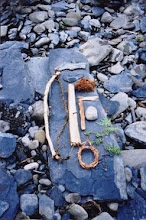
There is a time in my skills practice where I get stuck. It's familiar by now, and I can feel it coming now, instead of realizing it three weeks late.
Some people call it hitting the wall. Writers call it 'writer's block'. Athletes call it 'the plateau', where no matter how much you try, you just can't get over your perceived limits in lifting weights, or running times, or whatever it is you are working on.
Well, it is true with wilderness skills too. For some people, it is about getting outside, sleeping in their shelter, making a fire, etc. Others have a fear of failure in learning something new and worrying that it will be too difficult to master. Or it can be just hard to fight the inevitable pull of computers, video games, hanging out with family and friends, or doing other chores and projects.
I know pretty much all of the above.
Can you tell when you are avoiding something? For me, it shows up when I start doing all kinds of projects that I usually don't like to do, which I use as an excuse for not doing whatever skill I am being blocked on! For example, I will suddenly start cleaning the laundry room, or the basement, or cleaning out my car, (something I usually avoid because I am 'too busy'!) instead of figuring out my skill or life problem.
I know my inner process. I know that I will avoid things that might have bad news associated, or might not look like I know what I am doing. One time I just didn't go back to my shelter because I knew it wasn't really built right. It leaked. It wasn't warm. It needed to be rebuilt and done over. It was a lot of work and I just didn't want to deal with it.
Another skill where I had a mental block was flint knapping. I was fine with making stone tools for survival uses, but I didn't know how to make good arrowheads, points, knives, etc. At least, nothing that looked like authentic native tools. So I just avoided it.
In the end, I got familiar with the mental fight, the process of avoidance and mental chatter that leads nowhere. That prevents me from growing and learning. I knew what it takes to break that argument down, for myself, and how to move through it.
So here are three suggestions that you might be able to use in getting through your own mental blocks:
One: InspirationIf you find yourself bouncing off the walls of wilderness skills excuses, you probably just aren't quite inspired enough. Committed is another word that can be used in describing it. Think of it like a scale, where you have a balance of hard work and reward. Where do you get inspiration? Well, books and stories are one place. Talking with a mentor, someone you trust, can be another. Write down your goal and include how it helps you in your overall plan, completes you as a person, as an instructor, etc. Those are a good place to start.
Two: Moderate your ExpectationsEvery skill has steps that you need to take to grow and master. Break down your belief that you will get a fire with a hand drill every single time you try. Let go of the expectations and see if you can look at the skill fresh, without putting all of this extra pressure on yourself.
Give yourself small victories, accomplishments that you can celebrate as important blocks to build your foundation of your growing skill. Savor each 'win' and try to think long term. It takes years to master the skills of survival, and you can't expect to circumvent the hands of time!
Three: Get SupportFind someone who can support you as you struggle, as you triumph, as you work your butt off! That is the secret of the Earth Skills Correspondence Course, where you have a personal mentor who can listen, give feedback, help through the difficulties and understand when you are hitting a wall.
Sometimes, when you are working with things that are new, you have to protect yourself from negative opinions, surroundings, or environments. You might have to practice in private, so you can have some space to make mistakes and figure things out while you work. Be positive, and make sure those who are around you are positive as well. This is harder than it looks, but it is key to building up a positive environment where you will grow and meet your goals!
Good luck and let me know if this helps you out in any way.



















